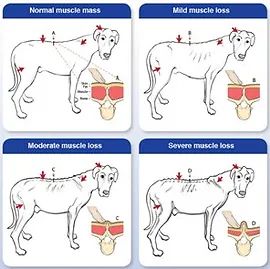Obesity in Companion Animals
Pet obesity is no joke. The 2018 survey by the Association for Pet Obesity Prevention indicated that 55.8% of dogs and 59.5% of cats were overweight or obese. This totals 50.2 million dogs and 56.5 million cats (2017) in the United States with increased weight and decreased life span.
A 14-year lifespan study on dogs conducted by the nutritionists with Purina Institute concluded that when fed a restricted-fed diet (measured diet) over a free feeding diet (non-measured diet), the median life span increased by 15%, an average of 1.8 years. Additionally, there was more time before the onset of signs related to chronic and age-related diseases with lean-fed dogs.
Obesity is a disease of all animals alike and can lead to numerous consequences that shorten the span and quality of life. Learn more about obesity and how to combat it in your pet to give them their best life possible.
What is Obesity?
Obesity is defined as 25% or more above ideal body weight. This can be measured in body condition score, a semi-objective measurement of weight, which involves evaluating certain points on a dog or animal for fat accumulation. These areas include over the ribs, at the waist, on the butt (rump), and in cases of overly obese animals, on the neck and limbs. It is measured on a scale of 1 to 9 with 4-5/9 constituting an ideal body weight. For each point above 5, the pet is 10% overweight. For example, a 7/9 equals 20% overweight.
The body can also be assessed for muscle condition score. The muscles assessed are the head muscles, the muscles along the sides of the spine, the shoulder muscles, and the thigh muscles. This is graded from normal muscle mass (1 out of 4) to severe muscle loss (4 out of 4)
Consequences to Obesity
Obesity decreases life by 15% and brings serious co-morbidities or other diseases associated with obesity.
The most common related conditions are mobility disorders, such as arthritis, torn ligaments in the knee, herniated disks in the spine, and other spinal changes; endocrine disorders, such as hypothyroidism (low thyroid hormone) and diabetes; high blood pressure and heart disease; and other organ dysfunction like liver, kidney, and urinary tract disease.
Additionally, obesity has been linked to inflammatory conditions and certain forms of cancer.
Causes of Obesity
The cause of obesity can be broken down into either increased calorie consumption or decreased calorie spending. This is influenced by many factors, such as human-related, animal-related, or environment-related.
Excess calorie consumption can be due to overfeeding of the primary diet or overfeeding of treats or people food. This can be counteracted by regular weight checks, measuring of diet, and limiting treats to no more than 10% of caloric intake.
Animal related factors leading to obesity can be genetic predisposition, aging, or a consequence of spaying and neutering which changes in metabolism. Moreover, a decrease in exercise, especially in warm Las Vegas summer, decreases calorie burning and reduces muscle mass which helps with glucose and fat metabolism.
In order to prevent obesity, an individualized diet and exercise plan can be adopted with regular weight monitoring to keep your pet in tip-top shape.
What about other animals?
Birds
Pet birds are also frequently obese, owing to old-school feeding habits, such as an all-seed diet. Obesity birds can lead to serious consequences like fatty liver disease, heart disease, clogged arteries (atherosclerosis), stroke, or cancer. They are also predisposed to fatty tumors, lipomas or xanthomas, which may require surgical removal under anesthesia. The species most commonly predisposed to obesity include Amazon parrots, budgies, canaries, cockatiels, cockatoos, and quaker parakeets
The best way to kick off weight loss in birds is to switch to a pelleted based diet (Mazuri and Zupreem are great brands) and reduce seed consumption to only treats. These formulated diets should be low in calories and fat content and high in fiber and should be measured and tracked daily. Also, encouraging activity and exercise using foraging toys, supervised time outside of the cage, and increasing movement in the cage with additional toys, perches, ladders, and platforms.
Reptiles
Reptiles come in all shapes and sizes and it can be difficult to assess if your reptile is over or underweight. Husbandry also a large influence on metabolism and weight. Light, temperature, and humidity of the environment plays into a reptile’s overall body condition. It is important to make sure that each reptile has an appropriate diet for its lifestyle, whether it is an herbivore, omnivore, or carnivore as well as appropriate nutrient supplements.
Body condition scoring can be difficult in reptiles. For lizards, body condition is assessed by how well bones can be skin through the skin along the spine, skull, ribs, leg bones, and hips. Obese lizards store their fat in the tail, along their spine and ribs, and under their neck.
Tortoises and turtles are the most difficult to assess for body condition. A few clues may signal obesity; They may feel heavy when picked up, have bug eyes due to fat deposits behind the eyes, or may not be able to bring arms and legs back into their shells.
Snakes can be assessed by feeling the ribs and spine. Obese snakes can have a less tubular appearance with uneven bodies and the skin between the scales will be visible.
Following appropriate nutritional guidelines and encouraging exercise of your reptile through enriching activities such as hiding food to encourage foraging and supervised exercise time, such as walks, swimming, or playpens.
Any animal can become obese and benefit for regular veterinary examinations to assess for physical health and appropriate nutrition.
A 14-year lifespan study on dogs conducted by the nutritionists with Purina Institute concluded that when fed a restricted-fed diet (measured diet) over a free feeding diet (non-measured diet), the median life span increased by 15%, an average of 1.8 years. Additionally, there was more time before the onset of signs related to chronic and age-related diseases with lean-fed dogs.
Obesity is a disease of all animals alike and can lead to numerous consequences that shorten the span and quality of life. Learn more about obesity and how to combat it in your pet to give them their best life possible.
What is Obesity?
Obesity is defined as 25% or more above ideal body weight. This can be measured in body condition score, a semi-objective measurement of weight, which involves evaluating certain points on a dog or animal for fat accumulation. These areas include over the ribs, at the waist, on the butt (rump), and in cases of overly obese animals, on the neck and limbs. It is measured on a scale of 1 to 9 with 4-5/9 constituting an ideal body weight. For each point above 5, the pet is 10% overweight. For example, a 7/9 equals 20% overweight.
The body can also be assessed for muscle condition score. The muscles assessed are the head muscles, the muscles along the sides of the spine, the shoulder muscles, and the thigh muscles. This is graded from normal muscle mass (1 out of 4) to severe muscle loss (4 out of 4)
Consequences to Obesity
Obesity decreases life by 15% and brings serious co-morbidities or other diseases associated with obesity.
The most common related conditions are mobility disorders, such as arthritis, torn ligaments in the knee, herniated disks in the spine, and other spinal changes; endocrine disorders, such as hypothyroidism (low thyroid hormone) and diabetes; high blood pressure and heart disease; and other organ dysfunction like liver, kidney, and urinary tract disease.
Additionally, obesity has been linked to inflammatory conditions and certain forms of cancer.
Causes of Obesity
The cause of obesity can be broken down into either increased calorie consumption or decreased calorie spending. This is influenced by many factors, such as human-related, animal-related, or environment-related.
Excess calorie consumption can be due to overfeeding of the primary diet or overfeeding of treats or people food. This can be counteracted by regular weight checks, measuring of diet, and limiting treats to no more than 10% of caloric intake.
Animal related factors leading to obesity can be genetic predisposition, aging, or a consequence of spaying and neutering which changes in metabolism. Moreover, a decrease in exercise, especially in warm Las Vegas summer, decreases calorie burning and reduces muscle mass which helps with glucose and fat metabolism.
In order to prevent obesity, an individualized diet and exercise plan can be adopted with regular weight monitoring to keep your pet in tip-top shape.
What about other animals?
Birds
Pet birds are also frequently obese, owing to old-school feeding habits, such as an all-seed diet. Obesity birds can lead to serious consequences like fatty liver disease, heart disease, clogged arteries (atherosclerosis), stroke, or cancer. They are also predisposed to fatty tumors, lipomas or xanthomas, which may require surgical removal under anesthesia. The species most commonly predisposed to obesity include Amazon parrots, budgies, canaries, cockatiels, cockatoos, and quaker parakeets
The best way to kick off weight loss in birds is to switch to a pelleted based diet (Mazuri and Zupreem are great brands) and reduce seed consumption to only treats. These formulated diets should be low in calories and fat content and high in fiber and should be measured and tracked daily. Also, encouraging activity and exercise using foraging toys, supervised time outside of the cage, and increasing movement in the cage with additional toys, perches, ladders, and platforms.
Reptiles
Reptiles come in all shapes and sizes and it can be difficult to assess if your reptile is over or underweight. Husbandry also a large influence on metabolism and weight. Light, temperature, and humidity of the environment plays into a reptile’s overall body condition. It is important to make sure that each reptile has an appropriate diet for its lifestyle, whether it is an herbivore, omnivore, or carnivore as well as appropriate nutrient supplements.
Body condition scoring can be difficult in reptiles. For lizards, body condition is assessed by how well bones can be skin through the skin along the spine, skull, ribs, leg bones, and hips. Obese lizards store their fat in the tail, along their spine and ribs, and under their neck.
Tortoises and turtles are the most difficult to assess for body condition. A few clues may signal obesity; They may feel heavy when picked up, have bug eyes due to fat deposits behind the eyes, or may not be able to bring arms and legs back into their shells.
Snakes can be assessed by feeling the ribs and spine. Obese snakes can have a less tubular appearance with uneven bodies and the skin between the scales will be visible.
Following appropriate nutritional guidelines and encouraging exercise of your reptile through enriching activities such as hiding food to encourage foraging and supervised exercise time, such as walks, swimming, or playpens.
Any animal can become obese and benefit for regular veterinary examinations to assess for physical health and appropriate nutrition.



